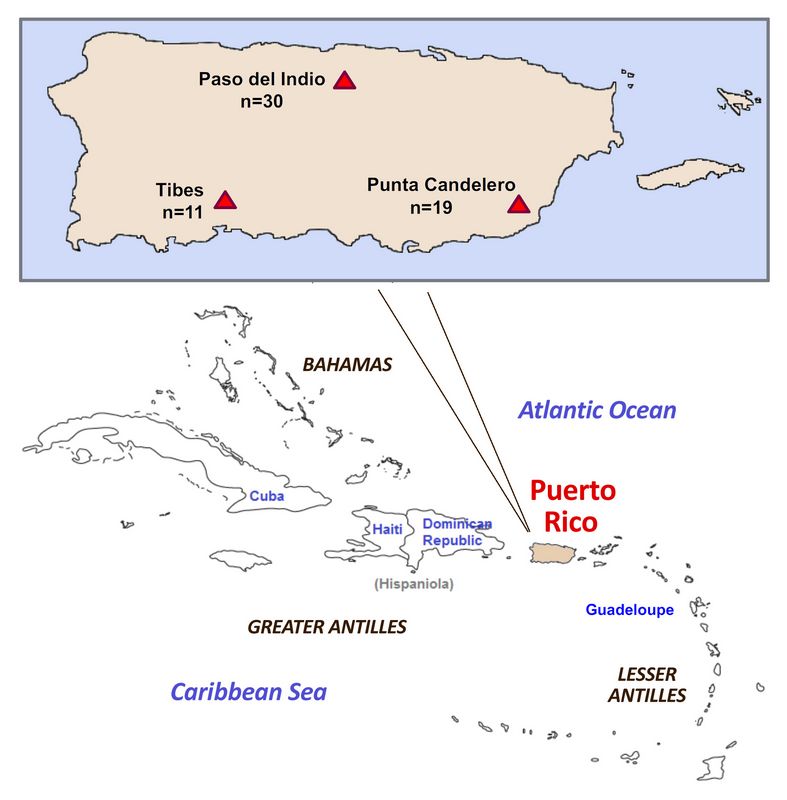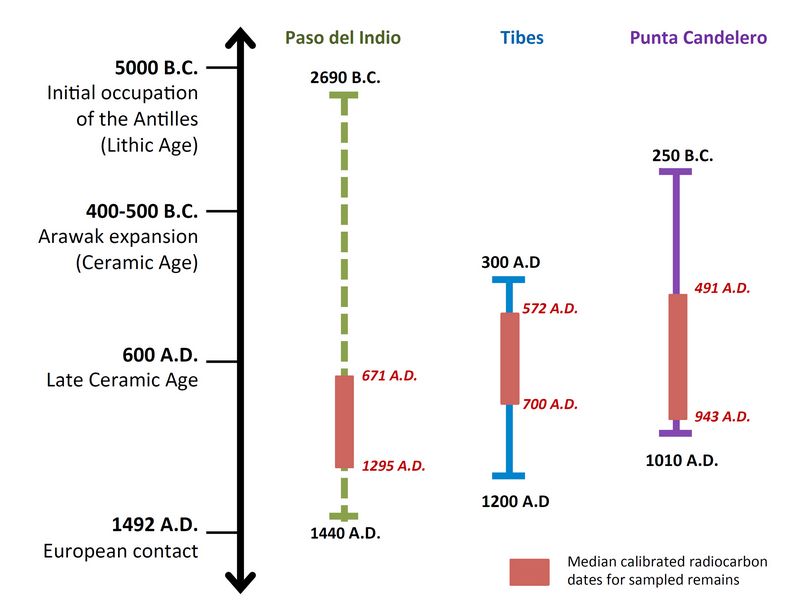Rust Family Foundation: Archaeology Grants Program
Reconstructing the Peopling of
Pre-Contact Puerto Rico through Ancient DNA Analysis.
[RFF-2016-08]
Principal Investigator: Maria Nieves-Colón, Arizona State University
[RFF-2016-08]
Principal Investigator: Maria Nieves-Colón, Arizona State University
 Importance
of the Project
Importance
of the Project Debate remains regarding how many migrants settled the island of Puerto Rico in antiquity, where they came from, and how these processes influenced social interaction networks across the ancient Caribbean basin. This investigation used ancient mitochondrial DNA obtained from human skeletal remains excavated in three pre-contact sites in Puerto Rico: Paso del Indio, Tibes and Punta Candelero (dated A.D. 500-1300), to examine the role of migration and genetic admixture in the population history of pre-contact Puerto Rican communities.
Fig.1: Location of Puerto Rico and the three sites with DNA samples.
Previous Research
Previous archaeological research has indicated that Native American groups occupied the Caribbean island of Puerto Rico for 4000 years before present, until European colonization in 1493. The first recorded archaeological site in the Caribbean islands (also known as the Antilles) is Banwari Trace in Trinidad, dated to 7000 BC, while the earliest on Puerto Rico dates to 3000 BC in what has become known as the Lithic Age. Based on the similarity of their flaked stone tools with those of coeval populations in Belize and Honduras, one hypothesis is that these early groups entered the Antilles from Central America, into Cuba and then to the other islands, but other origin regions have also been proposed.
Archaeological evidence also indicates a later migration to the Antilles between 500 and 400 BC (the Ceramic Age) of groups with elaborate pottery and widespread agriculture who arrived in Puerto Rico by 200 BC. Similarities in ceramic tradition suggest these were Arawak speaking groups from South America, specifically the Amazonian Orinoco region (Rouse 1992). In one model, these Arawak speakers are thought to have displaced existing groups and become the sole ancestors of later Antillean cultures. However, the nature and extent of the interaction between Lithic Age and Ceramic Age groups remains a topic of debate.
Although there is archaeological evidence of continuous interaction between ancient Puerto Rican groups and other Caribbean communities, the role of genetic exchange in maintaining these social networks is currently unknown. While many researchers agree that there was extensive human movement into Puerto Rico and other islands during the pre-contact era, the source of these populations, the nu
 mber of migratory waves, and the
extent and role of genetic admixture in this process remains unclear.
At the local scale, there is broad agreement that ancient inter-island
communities engaged in strong and continuous interaction, but the
precise nature and mechanisms for this interaction (e.g. trade, kin
networks, spousal exchange, political alliances) is elusive.
mber of migratory waves, and the
extent and role of genetic admixture in this process remains unclear.
At the local scale, there is broad agreement that ancient inter-island
communities engaged in strong and continuous interaction, but the
precise nature and mechanisms for this interaction (e.g. trade, kin
networks, spousal exchange, political alliances) is elusive.Fig.2: Chronology of the three sites.
Project Funded in 2016 [RFF-2016-08]
Goals:
The project had two primary goals:
. 1) Regional: To determine how ancient populations in Puerto Rico were related to continental Native American groups, and elucidate their potential origins. Specifically, this investigation tested whether Ceramic Age populations in Puerto Rico share genetic affinity with native populations from both Central and South America or solely with South American groups. If the latter was supported, this would suggest that genetic variation in ancient Puerto Rican populations stemmed uniquely from the expansion of South American Arawak-speaking populations into the Antilles approximately 2,500 years before present.
. 2) Local: To determine the extent of gene flow in the pre-contact Caribbean, and infer its role in maintaining local social interaction networks during antiquity. Specifically, this project tested whether local interaction at intra- and inter-island scales was accompanied by significant gene flow (or not) by comparing ancient DNA data from pre-contact Puerto Rico with publicly available mtDNA data from coeval Antillean groups.
Secondary project goals were to optimize protocols for increased ancient DNA recovery from skeletal remains from tropical environments and to broaden understanding of the genetic relationships between modern Puerto Ricans and pre-contact populations. Overall the project aimed to reassess archaeological models for the peopling of Puerto Rico and the Caribbean, and explore how migration and admixture shaped the biocultural diversity of ancient Caribbean communities. Lastly, the investigators also aimed to disseminate project results to the public and further education through training and outreach.
Methodology:
The project investigated ancient DNA to characterize migration into pre-contact Puerto Rico, trace gene flow between ancient Caribbean communities, and examine the extent of genetic continuity between ancient groups and modern Puerto Ricans. Dental remains from 60 individuals (dated between A.D. 500–1300) were collected from three archaeological sites: Tibes, Paso del Indio and Punta Candelero and sampled for ancient DNA remains.
Results:
Using target capture and next-generation sequencing techniques, Nieves-Colón obtained 27 complete mitochondrial genomes and partial autosomal genotypes from one individual. Results indicate there is a high proportion of Native American haplogroups A2 and C1 in this sample (29% and 55%, respectively). This distribution, as well as the haplotypes represented, supports a primarily South American origin for pre-contact populations, but does not exclude possible contributions from other American regions.
In addition, this study showed two identical mitochondrial (mtDNA) haplotypes shared between pre-contact and extant Puerto Rican populations. These lineages were not observed in any other population in a dataset of 735 complete mitochondrial genomes collected from the literature. This finding suggests there is some genetic continuity over time in Puerto Rico despite the large scale of contact era demographic shifts. Lastly, Nieves-Colón observed limited instances of mtDNA lineage sharing between coeval pre-contact island populations, suggesting that female-mediated gene flow (e.g. in exchange of women between islands) was not essential to Pan-Caribbean social interaction. Project findings contribute to a more complete reconstruction of pre-contact population history in the Caribbean and increase understanding of how ancient migration and admixture has shaped the biological and cultural diversity of modern Puerto Ricans.
References:
Rouse I. 1992. The Tainos: Rise & Decline of the People who Greeted Columbus. New Haven: Yale University Press.
.
Recent Foundation grants: general Archaeology Grants Program w/map
Copyright © 2018 Rust Family Foundation